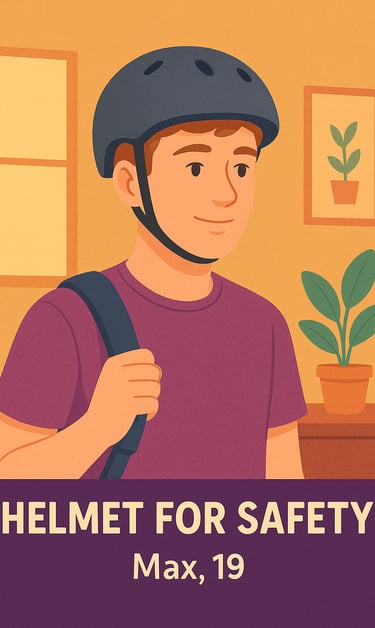Generalized Atonic Seizures: Understanding “Drop Attacks” Through Max’s Story
Atonic seizures can be frightening, sudden, and risky, especially when falls occur. This article breaks down what generalized atonic seizures are, why they happen, who they affect, and how they’re treated. Through the story of Max, a young adult navigating life with drop attacks, readers gain insight into the emotional and practical realities of living with this type of epilepsy and how support, awareness, and safety strategies can change everything.
Dr. Clotilda Chinyanya
11/24/20254 min read


Max’s Story: When the Body “Switches Off”
Max was 19 when he first collapsed without warning.
One second he was lifting a box at his new retail job, and the next he was on the floor bruised, confused, and embarrassed. His coworkers rushed over, and someone assumed he had tripped. Max laughed it off, but deep down he was shaken. It kept happening, once when he was walking up the stairs, another time in the middle of a conversation. He couldn’t remember the exact moment he dropped, only the shock of being on the ground afterward.
A turning point came when Max fell outside and struck his forehead on the sidewalk. The doctor in the emergency room asked questions none of the others had:
“Did you lose muscle tone? Did your body go limp before the fall? Were you aware during the episode?”
The doctor suspected generalized atonic seizures, sometimes called drop attacks.
After EEG testing, Max finally had answers. His brain and not his clumsiness was causing these sudden collapses. He began treatment, learned strategies to stay safe, and he even chose to wear a subtle protective helmet during certain activities. Max still has tough days, but he now understands what’s happening inside his brain and that awareness gave him back control.
Generalized Atonic Seizures - What Everyone Should Know
Atonic seizures are among the most misunderstood seizure types. They can be incredibly brief, but the consequences especially from falls can be serious. Let’s break down what they are, why they happen, and what life looks like for people like Max.
What Are Generalized Atonic Seizures?
“Atonic:” Loss of muscle tone
Generalized onset: Seizure activity affects both sides of the brain
Last only seconds (often 2–15 seconds)
Cause the head, upper body, or entire body to suddenly go limp
People may:
✔ Drop objects
✔ Nod or slump forward
✔ Collapse to the ground like a rag doll
✔ Lose awareness briefly
These are often called:
Drop attacks
Drop seizures
Akinetic seizures
Because awareness is altered and the body can’t protect itself during the fall, injuries such as bruises, cuts, broken bones, and head trauma are common.
Who Gets Atonic Seizures?
Most commonly begin in childhood
Often associated with epilepsy syndromes such as:
Lennox–Gastaut syndrome
Dravet syndrome
Can continue into adulthood, as in Max’s case
Many people experiencing these seizures also live with:
Other seizure types
Intellectual impairment (more common in childhood-onset cases)
Why Do They Happen?
Atonic seizures result from:
A sudden burst of abnormal electrical activity in areas that control posture
Signaling becomes disrupted → muscles lose tension instantly
Think of the body like a puppet with strings:
When the “strings” go slack: the body drops
The underlying cause may be:
Genetic
Related to structural, immune, or metabolic brain conditions
Or sometimes unknown
How Are Atonic Seizures Diagnosed?
A neurologist typically uses:
✔ Medical history
✔ Witness accounts (descriptions or video)
✔ EEG to identify seizure patterns
✔ MRI or other imaging if needed
Because falls can be caused by heart or blood pressure issues, doctors may also evaluate:
Heart rhythm
Autonomic function
Accurate diagnosis is key because not all drop attacks are atonic seizures; some involve increased muscle tone, not loss.
Are Atonic Seizures Dangerous?
Yes, not because of the seizure itself, but due to the sudden falls.
Risks include:
Concussion
Dental injury
Fractures
Safety strategies are crucial:
Helmets or soft headgear
Avoiding stairs or sharp corners when seizures are frequent
Supervision during high-risk times
Activities like driving or operating machinery are generally unsafe if drop seizures are uncontrolled.
What Happens After the Seizure?
Recovery is often fast:
Muscle tone returns quickly
Confusion may be brief or absent
The biggest issue is usually the injury
Children usually resume activity right away, barely bothered, but caregivers must still assess for harm or injuries. A seizure cluster (several in a row) requires immediate medical attention.
Treatment Options
Medication is usually the first approach; however, medicines often only partially reduce drop attacks. Additional therapies may include:
Ketogenic diet, low glycemic index diet, or modified Atkins diet
Vagus nerve stimulation (VNS)
Corpus callosotomy (disconnects seizure spread between hemispheres)
Protective headgear for safety
Treatment is highly personalized because what works for one person may not for another.
Living with Atonic Seizures: What Max Wants You to Know
Max admits he still fears the unexpected, especially the moments when his brain “switches off.” But he’s also learned:
✔ He is not alone
✔ Epilepsy isn’t a personal failure
✔ Safety planning protects independence
✔ Open communication helps others understand how to assist
He now keeps a seizure alert card in his wallet and has trained his friends what to do if he collapses. Max continues his job with accommodations and confidence.
As he says:
“My falls don’t define me. Standing back up does.”
Supporting Someone with Atonic Seizures
Here’s how you can help:
Ensure space is safe when a seizure starts
Protect their head and body during the fall
Check for injuries afterward
Stay calm because reassurance matters
Know when to call emergency services
And most importantly, listen and believe their lived experience
When Is It an Emergency?
Call 911 or go to the ER if:
A seizure happens for the first time
There’s a serious injury
Multiple seizures occur back-to-back
The person doesn’t recover as usual
Hope Through Understanding
Atonic seizures may be brief, but their effects, both emotional and physical can linger. Awareness can prevent injuries, reduce stigma, and help people like Max live fuller and safer lives.
If you suspect you or someone you love may be having drop attacks:
➡ Reach out to a healthcare provider
➡ Seek an accurate diagnosis
➡ Explore treatment and safety options
Knowledge is safety. And safety brings freedom.
Further Reading:
Choose Knowledge:
